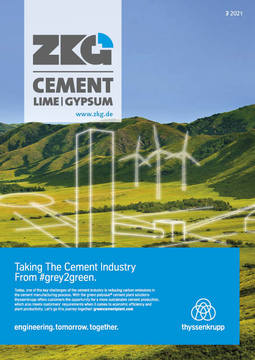The editors of ZKG Cement Lime Gypsum took the opportunity to speak to Dr Kai Schaefer, President of the German Lime Association (BVK) and Martin Ogilvie, CEO of the BVK, Cologne, about the lime industry roadmap.
Achieving climate neutral lime production by 2050 sounds very challenging. What are the main levers that can be used to achieve this goal?
Absolutely, the task and the responsibility are huge. For this reason, we as the lime industry want to tackle these challenges together. The central challenge is that in the production of lime, besides CO2 from combustion of the fuels in the lime kiln, around 2/3 of the total emissions result as unavoidable process CO2 from the deacidification of limestone. It is therefore not enough to convert our process to CO2-neutral fuels, we have to capture the CO2 emitted and process it so that it can be used further as a resource in downstream processes. Only in this way can we achieve CO2-neutral production for the lime industry.
What position are your member companies taking with regard to this goal?
We drew up the roadmap together, approved it on the board and presented it to the members. It is clear to all members that the road to a climate neutral production is imperative. We need, however, support from policy makers to be able to economically support research and the implementation of new technologies. Our member plants are also relying on this essential support.
What tasks are your member companies taking on?
The entire process is supported by our member companies. The projects and issues coordinated by the Lime Association are discussed in the monitoring committees, the work and the technical expertise of our member companies forming the basis. In addition comes the fact that member companies are conducting their own projects on CO2 reduction in their own plants.
What are the first steps for the forthcoming five years to “get underway”?
The first step was drawing up a common roadmap and communication of this to the policy-makers, the Federal German government and the public. These stakeholders will also be carefully monitoring how we meet our goals. As further steps, we shall work closely together with research institutes and networks to launch specific projects that address the goals described in the roadmap. A first project is already being implemented with the CO2-capture reactor presented here in this issue
With which partners do you work mainly?
Within the CO2-capture project we are working together with the Universities of Magdeburg and Bochum. Moreover, we are active in various networks like, for example, IN4climateNRW, or in dialog with the KEI, competence centre on climate change, to ensure exchange with other industries and scientific institutions. But we are also working closely together with our colleagues from the cement industry.
Particularly exciting is certainly the development of new technologies. What is the focus there at the moment and how does the future planning/realization of the already formulated ideas look?
The technical focus is currently on the research project “Lime-based solid-bed reactor for capturing CO2 from exhaust gases”. With this CO2 capture reactor, we have been able to filter off CO2 out of kiln exhaust gases after flue gas purification and capture near-pure CO2. The ongoing AiF research project is designed to lead to a real laboratory project that will then be conducted with a lime kiln in our industry. Our capture reactor could then be used in other industries. The topic of carbonation is currently another focus on which we are working together with our European Association EuLA.
What is personally close to your heart with regard to pursuing the goals in the roadmap?
It’s super that we have been able to find common goals for the German lime industry. Crucial will be that we not only find technical solutions for CO2 capture, but that we find solutions that are also economically viable for the entire industry. It is also absolutely exciting that we can make a key contribution to a CO2 sink with natural and enhanced carbonation.

